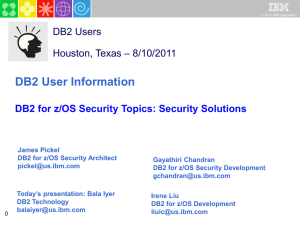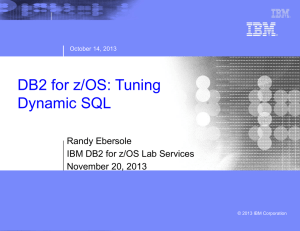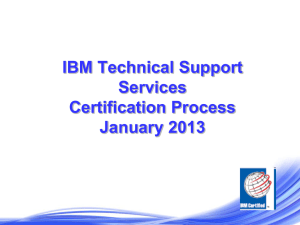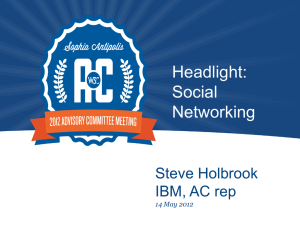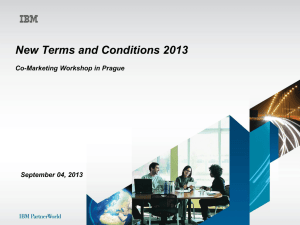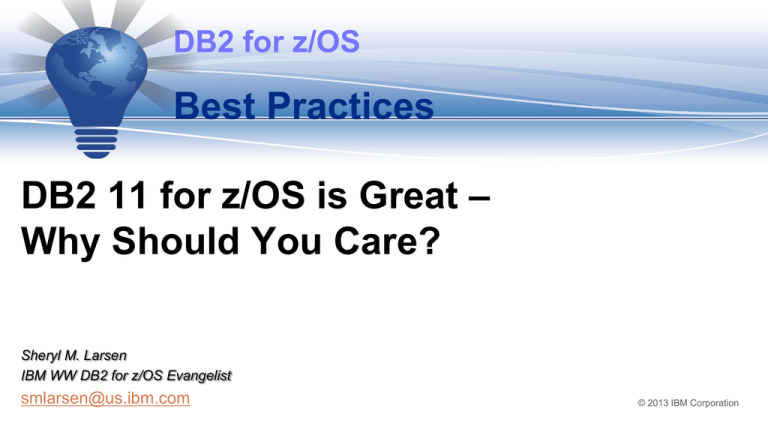
DB2 for z/OS
Best Practices
DB2 11 for z/OS is Great –
Why Should You Care?
Sheryl M. Larsen
IBM WW DB2 for z/OS Evangelist
smlarsen@us.ibm.com
© 2013 IBM Corporation
DB2 for z/OS Best Practices
IBM®
Sheryl M. Larsen
smlarsen@us.ibm.com
Sheryl Larsen is an internationally
recognized researcher, consultant and
lecturer, specializing in DB2 and is
known for her extensive expertise in
SQL. She co-authored a book, DB2
Answers, Osborne-McGraw-Hill, 1999.
She now works for IBM, but this
material was developed before joining
IBM and is the culmination of 25
years as an external consultant
specializing in superhuman efforts to
tune customer workloads.
© 2013 IBM Corporation
Her new title is IBM’s DB2 for z/OS
Evangelist. Other titles include:
President of the Midwest Database
Users Group,
IDUG Hall of Fame Speaker,
IDUG Hall of Fame Volunteer, and
Northern Illinois University Computer
Science Alumni Council Board Member
Sheryl has over 25 years experience
in DB2, has published articles, white
papers, webcasts: bmc.com, ca.com,
softbase.com,
ibm.developerworks.com
2
DB2 for z/OS Best Practices
© 2013 IBM Corporation
IBM®
3
DB2 for z/OS Best Practices
© 2013 IBM Corporation
IBM®
4
DB2 for z/OS Best Practices
© 2013 IBM Corporation
IBM®
5
DB2 for z/OS Best Practices
IBM®
Disclaimer/Trademarks
© Copyright IBM Corporation 2013. All rights reserved.
U.S. Government Users Restricted Rights - Use, duplication or disclosure restricted by GSA ADP Schedule Contract with IBM
Corp.
THE INFORMATION CONTAINED IN THIS DOCUMENT HAS NOT BEEN SUBMITTED TO ANY FORMAL IBM TEST AND IS DISTRIBUTED AS IS.
THE USE OF THIS INFORMATION OR THE IMPLEMENTATION OF ANY OF THESE TECHNIQUES IS A CUSTOMER RESPONSIBILITY AND
DEPENDS ON THE CUSTOMER’S ABILITY TO EVALUATE AND INTEGRATE THEM INTO THE CUSTOMER’S OPERATIONAL ENVIRONMENT.
WHILE IBM MAY HAVE REVIEWED EACH ITEM FOR ACCURACY IN A SPECIFIC SITUATION, THERE IS NO GUARANTEE THAT THE SAME OR
SIMILAR RESULTS WILL BE OBTAINED ELSEWHERE. ANYONE ATTEMPTING TO ADAPT THESE TECHNIQUES TO THEIR OWN
ENVIRONMENTS DO SO AT THEIR OWN RISK.
ANY PERFORMANCE DATA CONTAINED IN THIS DOCUMENT WERE DETERMINED IN VARIOUS CONTROLLED LABORATORY ENVIRONMENTS
AND ARE FOR REFERENCE PURPOSES ONLY. CUSTOMERS SHOULD NOT ADAPT THESE PERFORMANCE NUMBERS TO THEIR OWN
ENVIRONMENTS AS SYSTEM PERFORMANCE STANDARDS. THE RESULTS THAT MAY BE OBTAINED IN OTHER OPERATING ENVIRONMENTS
MAY VARY SIGNIFICANTLY. USERS OF THIS DOCUMENT SHOULD VERIFY THE APPLICABLE DATA FOR THEIR SPECIFIC ENVIRONMENT.
Trademarks
IBM, the IBM logo, ibm.com, and DB2 are trademarks of International Business Machines Corp., registered in many jurisdictions worldwide. Other
product and service names might be trademarks of IBM or other companies. A current list of IBM trademarks is available on the Web at “Copyright and
trademark information” at www.ibm.com/legal/copytrade.shtml.
IBM - A global computer products, services and solutions company based in the United States, IBM operates in more than 170 countries and has
nearly 427,000 employees. With thousands of business partners and computer products suppliers worldwide, IBM generates more than USD99 billion in
annual revenue. The company was founded in 1911 in Endicott, New York.
© 2013 IBM Corporation
6
DB2 for z/OS Best Practices
IBM®
DB2 11 for z/OS Enhancements for
Developers
DB2 Engine Components
Predicate Processing Intelligence
Optimizer Details
DB2 11 Performance Sweet Spots
Easier DB2 Version Upgrade – application
compatibility
Performance Improvements
– no REBIND needed
– REBIND required (with or without APREUSE)
– REBIND required (without APREUSE)
– DBA or application effort required
DDF Performance Improvements
SQL changes/new features for DB2 V11
Expanded Analytics Capabilities in DB2 11
Big Data Capabilities
© 2013 IBM Corporation
7
IBM®
DB2 for z/OS Best Practices
DB2 Engine Components
SQL Execution
Result
SQL
Optimizer
Work
Files
Stage 2 – z/OS
RID
Pool
Stage 1 – z/OS
Dynamic Statement
Cache
Catalog
Catalog
Meta Data
Directory
Directory
Access Plans
Buffer Pool
Buffer Manager
© 2013 IBM Corporation
Data
Index
RIDs
8
IBM®
DB2 for z/OS Best Practices
Page Processing – z/OS
Work
Files
Stage 2
Stage 1
Buffer Pool
Buffer Manager
Data
© 2013 IBM Corporation
4K,
8K,
16K,
32K
Index
9
IBM®
DB2 for z/OS Best Practices
Indexable Stage 1 Predicates
Predicate Type
32
DB2 11
New Stage 1
Predicates
COL = value
COL = noncol expr
COL IS NULL
COL op value
COL op noncol expr
COL BETWEEN value1 AND value2
COL BETWEEN noncol expr 1 AND noncol expr 2
COL BETWEEN expr-1 AND expr-2
COL LIKE 'pattern'
COL IN (list)
COL IS NOT NULL
COL LIKE host variable
COL LIKE UPPER 'pattern'
COL LIKE UPPER 'host-variable'
T1.COL = T2.COL
T1.COL op T2.COL
T1.COL = T2 col expr
T1.COL op T2 col expr
COL=(noncor subq)
COL = ANY (noncor subq)
(COL1,...COLn) IN (noncor subq)
COL = ANY (cor subq)
COL IS NOT DISTINCT FROM value
COL IS NOT DISTINCT FROM noncol expr
T1.COL1 IS NOT DISTINCT FROM T2.COL2
T1.COL1 IS NOT DISTINCT FROM T2 col expr
COL IS NOT DISTINCT FROM (noncor subq)
value BETWEEN COL1 AND COL2
value BETWEEN col expr AND col expr
SUBSTR(COLX, 1, n) = value
DATE(TS_COL) = value
YEAR(DT_COL) = value
CASE WHEN THEN ELSE END = value
© 2013 IBM Corporation
Stage 1 Predicates
Indexable
Stage 1
Y
Y
Y
Y
Y
Y
Y
Y
Y
Y
Y
Y
Y
Y
Y
Y
Y
Y
Y
Y
Y
Y
Y
Y
Y
Y
Y
Y
Y
Y
Y
Y
Y
Y
Y
Y
Y
Y
Y
Y
Y
Y
Y
Y
Y
Y
Y
Y
Y
Y
Y
Y
Y
Y
Y
Y
Y
Y
Y
Y
Y
Y
Y
Y
Y
Y
Predicate Type
13
COL <> value
COL <> noncol expr
COL NOT BETWEEN value1 AND value2
COL NOT IN (list)
COL NOT LIKE ' char'
COL LIKE '%char'
COL LIKE '_char'
T1.COL <> T2 col expr
COL op (noncor subq)
COL op ANY (noncor subq)
COL op ALL (noncor subq)
COL IS DISTINCT FROM value
COL IS DISTINCT FROM (noncor subq)
Indexable
Stage 1
N
N
N
N
N
N
N
N
N
N
N
N
N
Y
Y
Y
Y
Y
Y
Y
Y
Y
Y
Y
Y
Y
Four Points of Filtering
1.
Indexable = The predicate is a candidate for Matching Index access.
When the optimizer chooses to use a predicate in the probe of the index,
the condition is named Matching (matching the index). This is the first
point that filtering is possible in DB2.
2.
Stage 1 Index Screening = The Stage 1 predicate is a candidate for
filtering on the index leaf pages. This is the second point of filtering in
DB2.
3.
Stage 1 Data Screening = The Stage 1 predicate is a candidate for
filtering on the data pages. This is the third point of filtering in DB2.
4.
Stage 2 = The predicate is not listed as Stage 1 and will be applied on the
remaining qualifying pages from Stage 1. This is the fourth and final
point of filtering in DB2.
43 TOTAL !!
10
IBM®
DB2 for z/OS Best Practices
DB2 11 New Indexable Stage 1 Predicates
No longer worry about these:
– WHERE value BETWEEN COL1 AND COL2
– WHERE SUBSTR(COLX, 1, n) = value
– WHERE SUBSTR(COLX, 1, n) op value
– WHERE DATE(TS_COL) = value
– WHERE DATE(TS_COL) op value
In the DB2 11 documentation
Summary of Predicate
Processing
– WHERE YEAR(DT_COL) = value
– WHERE YEAR(DT_COL) op value
– WHERE value BETWEEN col expr AND col expr
– WHERE CASE expr = value
© 2013 IBM Corporation
The predicate might be indexable if expr contains
one of the following scalar functions:
DATE
YEAR
SUBSTR (if the start value for the substring is 1.)
11
IBM®
DB2 for z/OS Best Practices
Four Points of Filtering – DB2
1.
2.
3.
4.
WHERE C.LAST_NM LIKE ?
AND C.TOKEN_NR =
B.TOKEN_NR
AND C.ROLE_CD > ?
AND CASE C.SEX WHEN ‘X’ THEN ‘ABCDE’
END = ?
Indexable Stage 1 Probe
Stage 1 Index Filtering
Stage 1 Data Filtering
Type 2 Index
Stage 2
TOKEN_NR.
1 C1.C2.C3
Root Page
O O O
Non-Leaf Page
O O O
ROLE_CD
Non-Leaf Page
O O
Non-Leaf Page
O O O O
2
Leaf Page
o o o o o o
Leaf Page
o o o o o o
Leaf Page
o o o o o o
Leaf Page
o o o o o o
Leaf Page
o o o o o o
3
© 2013 IBM Corporation
Leaf Page
o o o o o o
Leaf Page
o o o o o o
Leaf Page
o o o o o o
Leaf Page
o o o o o o
4
12
DB2 for z/OS Best Practices
Visual Plan Graphs - Simple
13
© 2013 IBM Corporation
IBM®
DB2 for z/OS Best Practices
Visual Plan Graphs - Busy
14
© 2013 IBM Corporation
IBM®
DB2 for z/OS Best Practices
V11
IBM®
DB2 11 OLTP/Batch Performance Expectations
These are results from IBM testing
Performance expectations vary depending on many factors, including
–
Access path selection, Read/Write ratio, Number of rows returned
–
Number and type of columns returned, Number of partitions touched
–
Schema - Number of partitions defined, DPSI, etc
–
RELEASE option, data compression
–
Query costing, query rewrite, index skipping
© 2013 IBM Corporation
15
DB2 for z/OS Best Practices
DB2 11 Performance Sweet Spots
Write Intensive Batch
Queries
– With compressed tables
– With access path improvement
– With sort intensive workload
– Accessing multiple DPSI partitions
– IDAA with large result sets
Online transactions
– Write intensive transactions
– With large # of partitions (>200 partitions ) with REL(COMMIT)
– With large buffer pools
– With queries returning a large number of columns
– Chatty DDF applications with z/OS Communications Server
Cost saving from zIIP eligible address space SRB time
– DBM1 in data sharing
– MSTR address space for update intensive workloads
16© 2013 IBM Corporation
V11
IBM®
DB2 for z/OS Best Practices
IBM®
Impressive DB2 11 Performance Results!
Query
Batch
OLTP
XML
© 2013 IBM Corporation
IBM®
DB2 for z/OS Best Practices
DB2 11 The Foundation for Business Critical Analytics
DB2 for z/OS and
IBM DB2 Analytics Accelerator
OLTP Transactions
Real time data ingestion
High concurrency
Operational analytics
Standard reports
OLAP
Complex queries
18
© 2013 IBM Corporation
DB2 Native
Processing
• DB2 11 CPU savings
benefit query workloads
with or without IBM DB2
Analytics Accelerator
IBM®
DB2 for z/OS Best Practices
DB2/Accelerator Sweet Spots Do Not Overlap
OLTP Transactions
DB2 11 and Big Insights
provide this extended
capability
Operational analytics
Real time data ingestion
Advanced analytics*
Standard reports
OLAP
Complex queries
Historical queries
© 2013 IBM Corporation
IBM DB2 Analytics
Accelerator
DB2 Native
Processing
High concurrency
DB2 for z/OS Best Practices
IBM®
Enhancing DB2 11 Analytics on “z” with Big Data
Providing the connectors – User Defined Functions
Providing capability to allow DB2 applications to easily and
efficiently access these data sources
Hadoop Distributed File System
•New user-defined
functions
•New generic table
UDF capability
FS results on IBM BigInsights platform
© 2013 IBM Corporation
20
DB2 for z/OS Best Practices
IBM®
DB2 11 Support for Big Data Details
Analytic jobs can be specified using JSON Query Language (Jaql)
– Submitted to IBM’s Hadoop based BigInsights platform
– Results stored in HDFS format
A new generic, polymorphic, TABLE User Defined Function (HDFS_READ) reads the
Bigdata analytic result from HDFS
– For subsequent use in an SQL query
Must have a variable shape of HDFS_READ output table
– Its output schema is determined at query run-time
– DB2 11 supports generic table UDFs, enabling this function
A new function, JAQL_SUBMIT, enables invocation of IBM BigInsights Jaql from a DB2
application
– Returns the correct URL string for the HDFS result in VARCHAR(512) or ‘’
© 2013 IBM Corporation
21
IBM®
DB2 for z/OS Best Practices
Typical Customer Big Data Use Case
4.) DB2 reads the BigInsights result file
SELECT A.* FROM AGENT A JOIN
TABLE(HDFS_Read(JAQL_SUBMIT
result,’’)) AS …..
3.) BigInsights creates a file of results (names
and email addresses of
customers at risk)
22
1.) Email from all clients sent to an insuranc
company ingested into IBM’s BigInisghts
platform
IBM BigInsights
2.) DB2 kicks off a Hadoop job on BigInsights analyzes the emails and identifies customers
who have expressed dissatisfaction
DB2 joins the result with the Agent table and sends list of at-risk customers to their
mobile
© 2013 IBM
Corporationdevice
IBM®
DB2 for z/OS Best Practices
More HDFS_Read Examples
• INSERT INTO T1 SELECT a, b FROM TABLE
(HDFS_Read(‘http://9.30.11.27/data/controller/dfs/file1.csv',’’))
AS X(A INT, B DOUBLE, C INT);
• SELECT T1.*, hd.a, hd.b
FROM T1 JOIN TABLE
(HDFS_Read('http://9.30.11.27/data/controller/dfs/file1.csv', '‘))
X(A INT,B DOUBLE,C INT)
ON T1.x = X.c;
AS
• CREATE VIEW hadoopData AS
SELECT * FROM TABLE(
HDFS_Read('http://9.30.11.27/data/controller/dfs/file1.csv',’’)) AS X(A
INT, B DOUBLE, C INT);
23
© 2013 IBM Corporation
23
DB2 for z/OS Best Practices
Java Stored Procedure Enhancements
Current behavior is single threaded JVM for Java stored procedures
– 1 JVM per TCB in WLM-SPAS
– Large storage footprint per TCB
– Overhead starting JVMs
– Therefore recommended NUMTCB <= 8 per WLM application environment
– Performance and scalability implications for Java stored procedures
– 31-bit JVM
DB2 11 Java Stored Procedures use multi-threaded JVMs
– One 64-bit JVM per WLM-SPAS
– Less overhead to start JVM
– Smaller JVM storage footprint
– NUMTCB of 25 or more per WLM application environment is now possible
– Better scalability
– Object caching between stored procedures running in same JVM
– Requires JDK 1.6
– Corporation
IBM Data
© 2013 IBM
Server Driver for JDBC and SQLJ, JDBC 4.0
IBM®
DB2 for z/OS Best Practices
V11
IBM®
DB2 and IBM zIIP Add Value to Database Work
Portions of the following DB2 workloads in enclave SRB mode are eligible for zIIP*
DB2 9 in blue
DB2 10 in green
DB2 11 in red
1. DRDA over TCP/IP connections: up to 60% of the processing
DB2 9 for zOS remote native SQL procedures
DB2 9 XML parsing, schema validation
2. Requests that use parallel queries: up to 80% of the processing after reaching a CPU usage threshold
DB2 9 and DB2 10 remove restrictions for query parallelism enabling more queries to run with parallelism and therefore to potentially increase zIIP
eligibility
3. DB2 utilities: up to 100% of the processing
4.
LOAD, REORG and REBUILD functions used to maintain index structures and sort
DB2 10 RUNSTATS – options other than column group, inline
DB2 11 RUNSTATS column group and inline
Asynchronous processing that is charged to a DB2 address space (introduced in DB2 10, expanded in DB2 11): up to 100% of the
processing
DB2 10 buffer pool prefetch and deferred write
All other such asynchronous processing, except for P-lock negotiation
* NOTE: This information provides only general descriptions of the types and portions of workloads that are eligible for execution on Specialty Engines (e.g, zIIPs, zAAPs, and IFLs) ("SEs"). IBM authorizes customers to use IBM SE only to execute the
processing of Eligible Workloads of specific Programs expressly authorized by IBM as specified in the “Authorized Use Table for IBM Machines” provided at www.ibm.com/systems/support/machine_warranties/machine_code/aut.html (“AUT"). No other workload
processing is authorized for execution on an SE. IBM offers SE at a lower price than General Processors/Central Processors because customers are authorized to use SEs only to process certain types and/or amounts of workloads as specified by IBM in the
AUT.
26© 2013 IBM Corporation
DB2 for z/OS Best Practices
V11
IBM®
Easier DB2 Version Upgrade – application compatibility
New DB2 releases can introduce SQL behavior changes which can break existing applications
– For example, changes for SQL standards compliance
– Example: DB2 10 CHAR function with decimal input no longer returns leading zeros when there
is a decimal point
Application Compatibility (APPLCOMPAT) – new option for enforcement
–
APPLCOMPAT(WARN)
– Provide mechanism to identify applications affected by SQL changes
– Provide seamless mechanism to make changes at an application (package) level or at a system
level
–
APPLCOMPAT(VnnR1) – nn is the DB2 Version Number. V10R1 is the lowest release of DB2 catered for
–
CURRENT APPLICATION COMPATIBILITY – Dynamic SQL special register
– This mechanism will enable support for up to two back level releases (N-2)
– The release after DB2 10 will be the initial deployment of this capability
– DB2 10 will be the lowest level of compatibility supported
© 2013 IBM Corporation
2
8
IBM®
DB2 for z/OS Best Practices
Migration DB2 10 DB2 11 (V11R1)
DB2 10 New Function
Mode
DB2 11 Conversion Mode
DB2 11 Enabling New
Function Mode
(NFM) With SPE
CATMAINT UPDATE
(DSNTIJTC)
DB2 11 New Function Mode
(NFM)
CATENFM
COMPLETE
(DSNTIJNF)
CATENFM START
(DSNTIJEN)
DB2 10 Catalog
DB2 11 Catalog
1 – 2 months
2 hours
DB2 10
Libraries
1 week
Data Sharing
Coexistence
DB2 11
Libraries
Bind with APPLCOMPAT(V10R1) option only
IBM Confidential
© 2013 IBM Corporation
Bind with
APPLCOMPAT(V10R1) or
APPLCOMPAT(V11R1)
28
2
9
IBM®
DB2 for z/OS Best Practices
Migration DB2 11 DB2 11 + 1 (VnnR1)
DB2 11 New Function
Mode
DB2 11+1 Enabling New
Function Mode
DB2 11+1 Conversion
Mode
(NFM) With SPE
CATMAINT UPDATE
(DSNTIJTC)
DB2 11+1 New Function Mode
(NFM)
CATENFM
COMPLETE
(DSNTIJNF)
CATENFM START
(DSNTIJEN)
DB2 11 Catalog
DB2 11+1
Catalog
1 – 2 months
2 hours
DB2 11 Libraries
1 week
Data Sharing
Coexistence
DB2 11+1
Libraries
Bind with APPLCOMPAT(V10R1)
Or APPLCOMPAT(V11R1)
IBM Confidential
© 2013 IBM Corporation
Bind with
APPLCOMPAT(V10R1) or
APPLCOMPAT(V11R1)
Or APPLCOMPAT(VnnR1)
29
DB2 for z/OS Best Practices
V11
IBM®
Easier DB2 Version Upgrade...
Faster ENFM processing
– Lab measurement showed 16x faster in V11 vs. V10 using a large customer
catalog
– Note: V11 ENFM performance is sensitive to size of SYSLGRNX. Consider
running MODIFY RECOVER to clean up old entries if SYSLGRNX is very large
Access path stability improvements
Higher code quality stability levels
New workload Capture/Replay tooling can help testing of DB2 version upgrades
© 2013 IBM Corporation
DB2 for z/OS Best Practices
V11
IBM®
Performance Improvements – no REBIND needed
DDF performance improvements
–
Reduced SRB scheduling on tcp/ip receive using new CommServer capabilities
–
Improved autocommit OLTP performance
–
DRDA package based continuous block fetch
xProcs above the bar
–
31-bit Vstor relief enabled by RMODE 64 support in z/OS 1.13 and above
–
Enables other internal performance improvements
zIIP enablement for all SRB-mode DB2 system agents that are not response time critical
Avoid cross-memory overhead for writing log records
INSERT performance
–
Latch contention reduction for classes 6, 14, 19
–
CPU reduction for Insert column processing and log record creation
–
Data sharing LRSN spin avoidance
–
Page fix/free avoidance in GBP write
© 2013 IBM Corporation
32
DB2 for z/OS Best Practices
V11
IBM®
Performance Improvements – no REBIND needed…
Automatic index pseudo delete cleanup
–
DBA work would be required for fine tuning
ODBC/JDBC type2 performance improvements
–
Stored procedure invocation
Java stored procedure multi-threading improvements
Sort performance improvements
DPSI performance improvements for merge
Performance improvements with large number of partitions
XML performance improvements
Optimize RELEASE(DEALLOCATE) execution so that it is consistently better performing than
RELEASE(COMMIT)
–
Monitor # parent locks and cleanup internal structures when threshold is hit
IFI 306 filtering capabilities to improve Replication capture performance
Utilities
performance improvements
© 2013 IBM Corporation
33
V11
DB2 for z/OS Best Practices
IBM®
Performance Improvements – no REBIND needed…
ACCESS DATABASE command performance
DGTT performance improvements
–
Avoid incremental binds for reduced cpu
overhead
P-procs for LIKE predicates against Unicode
tables
Improved performance for ROLLBACK TO
SAVEPOINT
zEC12 integration for performance
improvements
–
Pageable 1M frames for DB2 CPU savings
(requires Flash Express)
–
Buffer pool control structures (retrofit to V10)
–
DB2 executable code (requires z/OS 2.1)
–
2G page frame size to position for extremely
large main memory sizes
–
Optimizer CPU and I/O cost balancing
improvements (can also benefit z196 and z10)
© 2013 IBM Corporation
Latch contention reduction and other high n-way scalability
improvements
Data sharing performance improvements
LRSN spin reduction with extended LRSNs
Castout performance
GBP write-around
Index split performance
34
DB2 for z/OS Best Practices
V11
IBM®
Performance Improvements – REBIND required (with or
without APREUSE)
Query transformation improvements – less expertise required to write performance SQL
–
–
Enhanced query rewrite to improve predicate indexability
–
new situations where non-indexable predicates can be rewritten by Optimizer to be indexable
–
Convert some common stage 2 predicates to indexable (YEAR(), DATE(), SUBSTR(col,1,x), value BETWEEN COL1 AND COL2)
–
Improved indexability for OR COL IS NULL predicates
–
Push complex predicates inside materialized views/table expressions
Enhanced pruning of "always true" and "always false" predicates
Enhanced duplicate removal
–
Lots of queries require duplicate removal: e.g. DISTINCT, GROUP BY, etc.
–
Dup elimination via sorting can be expensive
–
New techniques: Index duplicate removal, early out
–
Will not show in Explain table, need to look at IXSCAN_SKIP_DUPS column in DSN_DETCOST_TABLE to determine if sort
avoided
DDF and RDS runtime result set optimizations
–
Reduced DB2 CPU for IDAA queries
© 2013 IBM Corporation
35
DB2 for z/OS Best Practices
V11
IBM®
Performance Improvements – REBIND required (with or
without APREUSE)…
In-memory techniques
–
In-memory, reusable workfile
–
Sparse index (limited hash join support)
–
Non-correlated subquery using MXDTCACH
–
Correlated subquery caching
Non correlated subquery with mismatched length
Data decompression performance improvement
Select list do-once
–
Non column expressions in the select list can be executed once rather than per-row
Column processing improvements
–
Xproc (generated machine code) for output column processing
–
Optimized machine instructions for input/output column processing
© 2013 IBM Corporation
36
DB2 for z/OS Best Practices
V11
IBM®
Performance Improvements – REBIND required (with or
without APREUSE)…
RID overflow to workfile handled for Data Manager set functions
– DB2 10 added RID overflow to workfile
– DB2 11 adds support for set functions (COUNT, MAX, MIN etc) which was excluded in
DB2 10
Performance improvements for common operators
– MOVE, CAST, output hostvar processing, CASE, SUBSTR, DATE, others
DECFLOAT data type performance improvements
– Up to 23% CPU reduction for conversion to/from decfloat
– Approx. 50% cpu reduction in INSERT, FETCH for decfloat columns
– Helped further by zEC12 hw improvements for decimal floating point
© 2013 IBM Corporation
37
DB2 for z/OS Best Practices
V11
IBM®
Performance Improvements – REBIND required (without
APREUSE)
DPSI and page range performance improvements
– Page range screening for join/correlation predicates
– Parallelism optimization for DPSI access
Optimizer CPU and I/O cost balancing improvements
– Measured results: 3% to >30% performance improvement for query workloads
© 2013 IBM Corporation
38
DB2 for z/OS Best Practices
V11
IBM®
Performance Improvements – DBA or application effort
required
Suppress-null indexes
– Index entries not created when all values for indexed columns are NULL
–
Reduced index size, improved insert/update/delete performance, compatibility with other
DBMSes
– Improved utility CREATE INDEX performance
New PCTFREE FOR UPDATE attribute to reduce indirect references
DGTT performance improvements
– Non logged DGTTs
Global variables
– Easier, more efficient sharing of data between SQL statements
© 2013 IBM Corporation
39
DB2 for z/OS Best Practices
V11
IBM®
Performance Improvements – DBA or application effort
required
Extended optimization - selectivity overrides (filter factor hints)
– Improve optimizer’s ability to find the cheapest access path
– Collect filter factors for predicates in a Selectivity Profile
– Selectivity Profile is populated via BIND QUERY
Open dataset limit raised to 200K
Optimizer externalization of missing/conflicting statistics
– Identify missing statistics during bind/prepare/explain
– DBA or tooling to convert output to RUNSTATS input
© 2013 IBM Corporation
40
IBM®
DB2 for z/OS Best Practices
Current Process for Populating Statistics
STATSINT
DSNZPARM - minutes
Optimizer
Real-time Statistics
(RTS)
Which statistics
to collect?
TABLE(ALL)
INDEX(ALL)
KEYCARD*
HISTOGRAMS
COLGROUP
MCARD
Etc.
© 2013 IBM Corporation
Statistics
in Catalog
Tables
RUNSTATS
TS1
SYSTABLESPACESTATS
SYSINDEXSPACESTATS
in memory
statistics
INSERT
UPDATE
DELETE
REORG
TS2
IX1
IX2
41
IBM®
DB2 for z/OS Best Practices
DB2 11 – Optimizer Externalization of Missing
Statistics
Missing stats?
Conflicting stats?
BIND
REBIND
PREPARE
in memory
recommendations
STATSINT
Optimizer
DSNZPARM - minutes
SYSSTATFEEDBACK
Real-time Statistics
(RTS)
Tooling
Statistics
in Catalog
Tables
© 2013 IBM Corporation
SYSTABLESPACESTATS
SYSINDEXSPACESTATS
in memory
statistics
RUNSTATS
42
DB2 for z/OS Best Practices
IBM®
IBM SQL History - DB2 V1 vs. DB2 9 SQL
Inner Joins, Subqueries, GROUP BY,
HAVING, ORDER BY, 21+ Built-in Functions
Table Expressions, Complex Correlation, Global Temporary Tables, CASE,
100+ Built-in Functions, Limited Fetch, Scrollable Cursors, UNION
Everywhere, MIN/MAX Single Index Support, Self Referencing Updates
with Subqueries, Sort Avoidance for ORDER BY, and Row Expressions 2M
Statement Length, GROUP BY Expression, Sequences, Scalar Fullselect,
Materialized Query Tables, Common Table Expressions, Recursive SQL,
CURRENT PACKAGE PATH, VOLATILE Table Support, Star Join Sparse
Index, Qualified Column names, Multiple DISTINCT clauses, IS NOT
DISTINCT FROM, ON COMMIT DROP, Transparent ROWID Column, GET
DIAGNOSTICS, Stage1 unlike data types, Multi-row INSERT, Multi-row
FETCH, Dynamic Scrollable Cursors, Multiple CCSIDs per statement,
Enhanced UNICODE, and Parallel Sort, TRUNCATE, DECIMAL FLOAT,
VARBINARY, optimistic locking, FETCH CONTINUE, MERGE, call from
trigger, statement isolation, FOR READ ONLY KEEP UPDATE LOCKS, SET
CURRENT SCHEMA, client special registers, long SQL Object names,
SELECT FROM INSERT, UPDATE, DELETE, MERGE, INSTEAD OF TRIGGER,
Native SQL Procedure Language, BIGINT, file reference variables, XML,
FETCH FIRST & ORDER BY IN subselect and fullselect, caseless
comparisons, INTERSECT, EXCEPT, not logged tables
© 2013 IBM Corporation
43
DB2 for z/OS Best Practices
SQL Portfolio- DB2 9 z/OS vs. DB2 9.5 LUW
IBM®
Stage1 unlike data types, Multi-row INSERT, FETCH, Multi-row cursor UPDATE,
Dynamic Scrollable Cursors, Multiple CCSIDs per statement, GET
DIAGNOSTICS, Enhanced UNICODE, IS NOT DISTINCT FROM, VARBINARY,
FETCH CONTINUE, MERGE
Inner and Outer Joins, Table Expressions, Subqueries, GROUP BY, Complex Correlation,
Global Temporary Tables, CASE, 100+ Built-in Functions including SQL/XML, Limited
Fetch, Insensitive Scrollable Cursors, UNION Everywhere, MIN/MAX Single Index Support,
Self Referencing Updates with Subqueries, Sort Avoidance for ORDER BY, and Row
Expressions 2M Statement Length, GROUP BY Expression, Sequences, Scalar Fullselect,
Materialized Query Tables, Common Table Expressions, Recursive SQL, CURRENT
PACKAGE PATH, VOLATILE Table Support, Star Join Sparse Index, Qualified Column
names, Multiple DISTINCT clauses, ON COMMIT DROP, Transparent ROWID Column, call
from trigger, statement isolation, FOR READ ONLY KEEP UPDATE LOCKS, SET CURRENT
SCHEMA, client special registers, long SQL Object names, SELECT FROM INSERT,
UPDATE, DELETE, MERGE, INSTEAD OF TRIGGER, Native SQL Procedure Language,
BIGINT, file reference variables, XML, FETCH FIRST & ORDER BY IN subselect and
fullselect, caseless comparisons, INTERSECT, EXCEPT, not logged tables, DECIMAL
FLOAT, XQuery,TRUNCATE, OLAP Functions, Session variables, OmniFind, Spatial, ROLE
GROUPING SETS, ROLLUP, CUBE, Many Built-in Functions, SET CURRENT
ISOLATION , multi-site join, MERGE, ARRAY data type, global variables, Oracle
© 2013 IBM Corporation
44
syntax, XML enhancements
DB2 for z/OS Best Practices
DB2 10 z/OS vs. DB2 10 LUW
IBM®
Multi-row INSERT, FETCH & multi-row cursor UPDATE, Dynamic Scrollable Cursors, GET
DIAGNOSTICS, Enhanced UNICODE SQL, join across encoding schemes, IS NOT DISTINCT
FROM, VARBINARY, FETCH CONTINUE, MERGE, SELECT from MERGE, routine versioning,
timestamps w/timezone
Inner and Outer Joins, Table Expressions, Subqueries, GROUP BY, Complex Correlation, Global
Temporary Tables, CASE, 100+ Built-in Functions including SQL/XML, Limited Fetch, Insensitive Scroll
Cursors, UNION Everywhere, MIN/MAX Single Index, Self Referencing Updates with Subqueries, Sort
Avoidance for ORDER BY, and Row Expressions, 2M Statement Length, GROUP BY Expression,
Sequences, Scalar Fullselect, Materialized Query Tables, Common Table Expressions, Recursive SQL,
CURRENT PACKAGE PATH, VOLATILE Tables, Star Join Sparse Index, Qualified Column names, Multiple
DISTINCT clauses, ON COMMIT DROP, Transparent ROWID Column, Call from trigger, statement isolation
FOR READ ONLY KEEP UPDATE LOCKS, SET CURRENT SCHEMA, Client special registers, long SQL
object names, SELECT from INSERT, UPDATE or DELETE, INSTEAD OF TRIGGER, Native SQL Procedure
Language, BIGINT, file reference variables, XML, FETCH FIRST & ORDER BY in subselect & fullselect,
caseless comparisons, INTERSECT, EXCEPT, not logged tables, OmniFind, spatial, range partitions, data
compression, session variables, DECIMAL FLOAT, optimistic locking, ROLE, TRUNCATE, index & XML
compression, created temps, inline LOB, administrative privileges, implicit cast, date/time changes,
currently committed, moving sum & average, index include columns, row and column access control, time
travel query, XML enhancements
Updateable UNION in Views, GROUPING SETS, ROLLUP, CUBE, more Built-in Functions, SET
CURRENT ISOLATION, multi-site join, MERGE, MDC, XQuery,, additional data type (array, row,
cursor), global variables, even more vendor syntax, temp table compression, MODULEs
© 2013 IBM Corporation
45 45
DB2 for z/OS Best Practices
IBM®
DB2 11 SQL – Standard SQL support (not exhaustive, some features may be missing)
DB2 11 for z/OS and DB2 10.5 Linux, Unix & Windows
Multi-row INSERT, FETCH & multi-row cursor UPDATE, Dynamic Scrollable Cursors, GET DIAGNOSTICS,
Enhanced UNICODE SQL, join across encoding schemes, IS NOT DISTINCT FROM, VARBINARY, FETCH
CONTINUE, SELECT FROM MERGE, MERGE, routine versioning, transparent archive query
Inner and Outer Joins, Table Expressions, Subqueries, GROUP BY, Complex Correlation, Global Temporary
Tables, CASE, 100+ Built-in Functions including SQL/XML, Limited Fetch, Insensitive Scroll Cursors, UNION
Everywhere, MIN/MAX Single Index, Self Referencing Updates with Subqueries, Sort Avoidance for ORDER BY,
and Row Expressions, 2M Statement Length, GROUP BY Expression, Sequences, Scalar Fullselect, Materialized
Query Tables, Common Table Expressions, Recursive SQL, CURRENT PACKAGE PATH, VOLATILE Tables, Star
Join Sparse Index, Qualified Column names, Multiple DISTINCT clauses, ON COMMIT DROP, Transparent
ROWID Column, Call from trigger, statement isolation, FOR READ ONLY, KEEP UPDATE LOCKS, SET
CURRENT SCHEMA, Client special registers, long SQL object names, SELECT from INSERT, UPDATE or
DELETE, INSTEAD OF TRIGGER, SQL PL in routines, BIGINT, file reference variables, XML, FETCH FIRST &
ORDER BY in subselect & fullselect, caseless comparisons, INTERSECT, EXCEPT, MERGE not logged tables,
OmniFind, spatial, range partitions, data compression, DECFLOAT, optimistic locking, ROLE, TRUNCATE, index &
XML compression, created temps, inline LOB, administrative privileges, implicit cast, increased timestamp
precision, currently committed, moving sum & average, index include columns, row and column access controls,
time travel query, GROUPING SETS, ROLLUP, CUBE, global variables, Text Search functions, accelerated tables,
DROP COLUMN, array data type, XML enhancements
Updateable UNION in Views, more Built-in Functions, SET CURRENT ISOLATION, multi-site join, full
MERGE, MDC, XQuery, additional data type (row, cursor), even more vendor syntax, temp table
© 2013 IBM
Corporation
46
compression,
MODULEs
z
c
o
m
m
o
n
l
u
w
V11
DB2 for z/OS Best Practices
IBM®
Expanded Analytics Capabilities...
SQL Grouping Sets, including Rollup, Cube
–
Rollup is helpful in providing subtotaling along a hierarchical
dimension such as time or geography
–
CUBE is helpful in queries that aggregate based on columns from
multiple dimensions
DB2 support for IDAA V3 and V4 (rolled back to V10)
–
–
–
–
–
–
Support for static SQL
Propagating DB2 changes to the accelerator as they happen –
V11 improved CDC capture performance with new IFI 306 filtering
capabilities
Detect staleness of data via RTS
Reducing disk storage cost by archiving data in the accelerator
and maintaining the excellent performance for analytical queries:
High Performance Storage Saver
Workload Manager integration and better monitoring capabilities
Increasing the query off-load scope via new special register
CURRENT QUERY ACCELERATION
© 2013 IBM Corporation
High performance SPSS indatabase scoring via
PACK/UNPACK (rolled back
to v10)
Hadoop access via table
UDF
–
–
UDFs shipped with BigInsights
Uses new V11 generic table UDF
capability
JSON support
47
DB2 for z/OS Best Practices
IBM®
GROUP BY GROUPING SETS
A grouping sets specification allows multiple grouping clauses to be specified in a single
statement.
DB2 11 introduces support for 3 additional variants of GROUP BY
– GROUP BY GROUPING SET: fundamental building block for GROUP BY operations
– GROUP BY ROLLUP: Produces sub-total rows in addition to regular grouped rows.
– GROUP BY CUBE: Produces row summaries and grand totals
Example: Create a result set from the SALES table based on person and date.
SELECT WEEK(SALES_DATE) as WEEK, DAYOFWEEK(SALES_DATE) AS DAY,
SALES_PERSON, SUM(SALES) AS SOLD
FROM SALES
WHERE SALES_DATE > '1999-12-31’
GROUP BY GROUPING SETS
© 2013 IBM Corporation
(WEEK(SALES_DATE), DAYOFWEEK(SALES_DATE), SALES_PERSON)
48
DB2 for z/OS Best Practices
IBM®
GROUP BY GROUPING SETS results
© 2013 IBM Corporation
49
DB2 for z/OS Best Practices
IBM®
GROUP BY ROLLUP
An extension to the GROUP BY clause
Produces a result set that contains “sub-total” rows.
The sequence of the columns is significant.
GROUP BY ROLLUP (a, b, c) is equal to
GROUP BY (a, b, c) + GROUP BY (a, b) + GROUP BY (a) + grand-total
Example
SELECT WEEK(SALES_DATE) AS WEEK, DAYOFWEEK(SALES_DATE) AS DAY,
SALES_PERSON, SUM(SALES) AS SOLD
FROM SALES
WHERE SALES_DATE > '1999-12-31'
GROUP BY ROLLUP
(WEEK(SALES_DATE), DAYOFWEEK(SALES_DATE), SALES_PERSON)
ORDER
BY
WEEK(SALES_DATE), DAYOFWEEK(SALES_DATE), SALES_PERSON
© 2013 IBM
Corporation
50
50
DB2 for z/OS Best Practices
IBM®
GROUP BY ROLLUP results
© 2013 IBM Corporation
51
DB2 for z/OS Best Practices
IBM®
GROUP BY CUBE
An extension to the GROUP BY clause
Produces a result set that contains ROLLUP aggregation plus cross-tabulation rows.
The sequence of the columns is not significant.
GROUP BY CUBE (a, b, c) is equal to
GROUP BY (a, b, c) +
GROUP BY (a, b) + GROUP BY (a,c) + GROUP BY (b,c) +
GROUP BY (a) + GROUP BY (b) + GROUP BY (c) + grand-total
Example
SELECT WEEK(SALES_DATE) AS WEEK, DAYOFWEEK(SALES_DATE) AS DAY,
SALES_PERSON, SUM(SALES) AS SOLD
FROM SALES
WHERE SALES_DATE > '1999-12-31'
© 2013 IBM Corporation
GROUP
BY CUBE
52
52
DB2 for z/OS Best Practices
IBM®
GROUP BY CUBE results
© 2013 IBM Corporation
53
DB2 for z/OS Best Practices
IBM®
GROUP BY CUBE results contd.
© 2013 IBM Corporation
54
DB2 for z/OS Best Practices
IBM®
Best Practice Shops
Keep SQL skills up to date
Have a culture geared toward proper use of SQL
Have SQL code review policies and procedures prior to production
Monitor SQL performance on a regular basis
Move the access path initial review into the developer’s hands using tools – topic for
another day
© 2013 IBM Corporation
55
IBM®
DB2 for z/OS Best Practices
Recommended Reading
App
© 2013 IBM Corporation
Z
56


